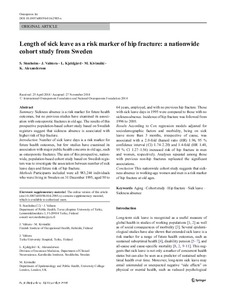Length of sick leave as a risk marker of hip fracture: a nationwide cohort study from Sweden
Stenholm S; Alexanderson K; Kivimäki M; Kjelgård L; Vahtera J
https://urn.fi/URN:NBN:fi-fe2021042714349
Tiivistelmä
Introduction Number of sick leave days is a risk marker for
future health outcomes, but few studies have examined its
association with major public health concerns in old age, such
as osteoporotic fractures. The aim of this prospective, nation-
wide, population-based cohort study based on Swedish regis-
ters was to investigate the association between number of sick
leave days and future risk of hip fracture.
Methods Participants included were all 983,244 individuals
who were living in Sweden on 31 December 1995, aged 50 to
64 years, employed, and with no previous hip fracture. Those
with sick leave days in 1995 were compared to those with no
sickness absence. Incidence of hip fracture was followed from
1996 to 2010.
Results According to Cox regression models adjusted for
sociodemographic factors and morbidity, being on sick
leave more than 3 months, irrespective of cause, was
associated with a 2.0-fold (hazard ratio (HR) 1.96, 95 %
confidence interval (CI) 1.74–2.20) and 1.4-fold (HR 1.40,
95 % CI 1.27–1.56) increased risk of hip fracture in men
and women, respectively. Analyses repeated among those
with previous non-hip fractures replicated the significant
associations.
Conclusion This nationwide cohort study suggests that sick-
ness absence in working-age women and men is a risk marker
of hip fracture at old ages.
Kokoelmat
- Rinnakkaistallenteet [19207]
